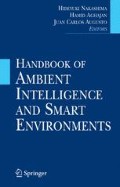Abstract
An important characteristic of ℌAmbient Intelligenceℍ (AmI) environments is the merging of physical and digital space (i.e. tangible objects and physical environments are acquiring a digital representation). As the computer disappears in the environments surrounding our activities, the objects therein are transformed to artifacts, that is, they are augmented with Information and Communication Technology (ICT) components (i.e. sensors, actuators, processor, memory, wire-less communication modules) and can receive, store, process and transmit information. Artifacts may be totally new objects or improved versions of existing objects, which by using the ambient technology, allow people to carry out novel or traditional tasks in unobtrusive and effective ways.
Preview
Unable to display preview. Download preview PDF.
References
Sachpazidis I.: @HOME: A modular telemedicine system. In: Mobile Computing in Medicine, Second Conference on Mobile Computing in Medicine, Workshop of the Project Group MoCoMed, GMDS-Fachbereich Medizinische Informatik & GI-Fachausschuss 4, Pages: 87–95, (2002), ISBN:3-88579-344-X
HEARTFAID project’s web site: http://www.heartfaid.org/
Domenico Conforti et al: HEARTFAID: A Knowledge Based Platform Of Services For Supporting Medical-Clinical Management Of Heart Failure Within Elderly Population. ICMCC, (2006)
Colantonio, S., Martinelli, M., Moroni, D., Salvetti, O., Perticone, F., Sciacqua, A., Gualtieri, A.: An approach to decision support in heart failure. In: Semantic Web Applications and Perspectives (SWAP 2007). Proceedings, Bari, Italy, Dip. di Informatica, Universita di Bari (2007)
A. Wood, G. Virone, T. Doan, Q. Cao, L. Selavo, Y. Wu, L. Fang, Z. He, S. Lin, and J. Stankovic: ALARM-NET: Wireless Sensor Networks for Assisted-Living And Residential Monitoring. Technical Report CS- 2006-11, Department of Computer Science, University of Virginia, (2006)
CAALYX project’s web site: http://www.caalyx.eu/
Boulos Maged N Kamel, Rocha Artur, Martins Angelo, Vicente Manuel Escriche, Bolz Armin, Feld Robert, Tchoudovski Igor, Braecklein Martin, Nelson John, Laighin Gear, Sdogati Claudio, Cesaroni Francesca, Antomarini Marco, Jobes Angela, Kinirons Mark: CAALYX: a new generation of location-based services in healthcare. In: International journal of health Geographics, (2007)
TeleCARE project’s web site: http://www.uninova.pt/∼telecare/
Camarinha-Matos L. M., Afsarmanesh H.: TeleCARE: Collaborative virtual elderly support communities. In: Proceedings of the 1st Workshop on TeleCare and Collaborative Virtual Communities in Elderly Care, TELECARE, Portugal, 13 April (2004).
Camarinha-Matos L. M., Castolo O., Rosas J.: A multi-agent based platform for virtual communities in elderly care. In: ETFA-2003, 9th IEEE International Conference on Emerging Technologies and Factory Automation Lisbon, Portugal, 16-19 September (2003)
Chronic: An Information Capture and Processing Environment for Chronic Patients in the Information Society. Final Project Report
MyHEART project’s web site: http://www.hitech-projects.com/euprojects/myheart/home.html
Habetha J.: The MyHeart Project: Fighting cardio-vascular diseases by prevention and early diagnosis. In: Proceedings of the 28th IEEE EMBS Annual International Conference New York City, USA, Aug 30-Sept 3, (2006)
Amft O. and Habetha J.: The MyHeart project. In: L. van Langenhove, editors, Book chapter in: Smart textiles for medicine and healthcare, pp. 275-297, Woodhead Publishing Ltd, Cambridge, England, February (2007). ISBN 1 84569 027 3
OLDES project’s web site: http://www.oldes.eu/press/busuoli.php
SAPHIRE project’s web site: http://www.srdc.metu.edu.tr/webpage/projects/saphire/index.php
Gokce Banu, Laleci Erturkmen ,Asuman Dogac, Mehmet Olduz, Ibrahim Tasyurt, Mustafa Yuksel, Alper Okcan: SAPHIRE: A Multi-Agent System for Remote Healthcare Monitoring through Computerized Clinical Guidelines. In: Book Chapter in Agent Technology and e-Health, Whitestein Series in Software Agent Technologies and Autonomic Computing, (2008)
MICAz Wireless Measurement System Specification sheet, XBOW Technology Inc.
Kristine Krapp (Ed.): Activities of Daily Living Evaluation., Encyclopedia of Nursing & Allied Health.Gale Group, Inc., (2002)
Bluetooth Core Specification 2.1, Bluetooth consortium, July (2007)
IEEE Standard for Information technology: Telecommunications and information exchange between systems Local and metropolitan area networks, Specific requirements. Part 11: Wireless LAN Medium Access Control (MAC) and Physical Layer (PHY) Specifications, 802.11, June (2007), Revision of IEEE Std 802.11-1999
TinyOS Wireless Measurement System, www.tinyos.net
HEARTS Project’s web site: http://www.ilsp.gr/hearts\_eng.html
eGadgets Project’s web site: http://www.extrovert-gadgets.net
Mobihealth project’s web site: http://www.mobihealth.org/
Dimitri Konstantas et al: MOBIHEALTH: Ambulant Patient Monitoring Over Public Wireless Networks. In: MEDICON 2004, July 31th - August 5th 2004, Island of Ischia, Naples, Italy, (2004)
SAPHE project’s web site: http://ubimon.doc.ic.ac.uk/saphe/m338.html
Atallah, L., Lo, B., Guang-Zhong Yang, Siegemund, F.: Wirelessly accessible sensor populations (WASP) for elderly care monitoring. In: Pervasive Computing Technologies for Healthcare, 2008. PervasiveHealth 2008, Jan. 30 2008-Feb. 1 (2008), pp 2-7, ISBN: 978-963-9799-15-8
SOPRANO project’s web site: http://www.soprano-ip.org/
M-POWER project’s web site:http://www.sintef.no/Projectweb/MPOWER/Home/
Author information
Authors and Affiliations
Corresponding authors
Editor information
Editors and Affiliations
Rights and permissions
Copyright information
© 2010 Springer Science+Business Media, LLC
About this chapter
Cite this chapter
Kameas, A., Calemis, I. (2010). Pervasive Systems in Health Care. In: Nakashima, H., Aghajan, H., Augusto, J.C. (eds) Handbook of Ambient Intelligence and Smart Environments. Springer, Boston, MA. https://doi.org/10.1007/978-0-387-93808-0_12
Download citation
DOI: https://doi.org/10.1007/978-0-387-93808-0_12
Publisher Name: Springer, Boston, MA
Print ISBN: 978-0-387-93807-3
Online ISBN: 978-0-387-93808-0
eBook Packages: Computer ScienceComputer Science (R0)

